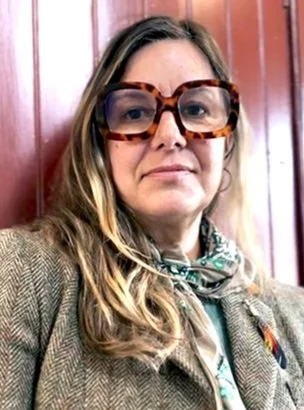Artist Statement 2025
My work examines how land, ancestry, and technology shape one another across time. In this work, I begin with photographs—images made in motion, often from trains—where landscapes pass quickly, mediated by speed, glass, and the camera’s frame. These are views tied to migratory experience: always arriving and departing, belonging in motion rather than at rest. They also reflect the digitized present, in which nature is filtered through screens, systems, and infrastructure, and where professions once tied to ecology and material knowledge dissolve into code and automation.
From these photographs, I build woven, embroidered, and layered works that slow perception back down. Thread becomes a way of re-encountering terrain, resisting both precision and nostalgia. Edges blur, lines drift, fragments reassemble—echoing memory, movement, and the speculative nature of inheritance. Prints are translated to shiny metals or lush cotton paper then fragmented and woven into new forms.
Motherland turns to Scotland, where landscapes seen from trains become woven horizons and embroidered interruptions. These works hold both recognition and estrangement, tracing how belonging can be felt yet unsettled, and how distance can become a form of knowing.
Across these projects, I treat making as a form of research and repair. Weaving, layering, and embroidery offer a counter-tempo to mechanization and data-driven lineage: a tactile way to inhabit land and time, to acknowledge erased knowledge and displaced labor, and to imagine connection without insisting on certainty.
Fatherland emerged from DNA population mapping that unexpectedly connected me to Italy. In Siena, I embroidered the small doodles etched in corners of cathedral attics or crypts onto translucent organza, layering sacred architecture and private musings with imagined ancestral presence. The work embraces uncertainty: identity not as proof, but as porous, hybrid, and partially legible—shaped by migration, disappearance, and the recent ability to trace what once lay hidden.
My practice sits between memory and speculation, image and thread, movement and return—asking how we navigate terrain in an era when both identity and landscape are scanned, accelerated, and increasingly abstracted from lived experience.I create artwork that explores nature, heritage, and the passage of time. In my series of tapestries and digital captures, the work aims to highlight the tension between the slow rhythms of nature and the accelerated, mechanized processes of the digital age. The contrast reflects larger forces in connection to place – land claimed and contested, histories preserved and erased, movement and rootedness – revealing how time, labor, and technology shape our connection to place.
My interest in nature, landscape, migration, and science can also be seen in my past installations, which consisted of sculptural, parasitic paintings that envelop architecture and challenge traditional notions of borders, protections, and artistic notions of the sublime by contrasting its awe-inspiring majesty with latent threats—viruses, swarms, and other unseen forces. Occupied with this work for about 10 years before the COVID-19 pandemic, it felt strangely prescient. After a large solo show of this work, I entered into a new research phase that is expressed in my current work.
